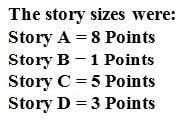Exam Details
Exam Code
:PMI-ACPExam Name
:PMI Agile Certified Practitioner (PMI-ACP)Certification
:PMI CertificationsVendor
:PMITotal Questions
:836 Q&AsLast Updated
:Apr 16, 2025
PMI PMI Certifications PMI-ACP Questions & Answers
-
Question 531:
The Sprint retrospective:
A. Is intended to promote continuous process improvements
B. Is held at the end of each release
C. Is conducted to provide the sponsor with key information on team progress
D. Is optional
-
Question 532:
At the end of first iteration, the team finishes User Stories A, Band 50% of C. What is the team velocity?

A. 11.5
B. 9
C. 14
D. 16
-
Question 533:
While developing a story during the iteration, team discovered new tasks that were not identified earlier. A newly discovered task is such that the User Story cannot be completed during the iterations. What are the most appropriate actions for the team to perform?
A. Let the Product Owner decide if there is still a way to meet the iteration goals.
B. Discuss the situation with the Scrum Master and see if there is still a way to meet the iteration goals.
C. Drop the User Story and inform the Product Owner that it will be delivered in the next iteration.
D. Modify the scope of other User Stories to allow completion of the Sprint backlog.
-
Question 534:
Suppose 8 new members joined the development team, and the team size is now 15. The daily Scrum is getting noisy and exceeding the 15 minutes time-box. What is the most effective way to address this situation?
A. Divide the team into two teams with minimum dependency and have two separate daily Scrums.
B. Do nothing; allow the large team to exceed the time-box by a few minutes each meeting.
C. Increase the time-box for the daily Scrum to 30 minutes.
D. Ask the team members to only update on the impediments and highlight only the important ones.
-
Question 535:
Suppose your team velocity is 8 story points, and the product backlog items are ordered by priority as shown below. If you are in a Sprint Planning meeting and need to commit to the User Stories for the next iteration, which ones will you select?

A. Story 1, 2, and 3
B. Story 1, 2, and 4
C. Story 1 and 2
D. Story 2, 3, and 4
-
Question 536:
During Sprint Planning, the architect is constanly estimating higher than everyone else, and team members are increasing their estimates to accommodate her. This is an example of:
A. Dominating
B. Influencing
C. Dictating D. Anchoring
-
Question 537:
The Agile artifact that describes the incremental nature of how a product will be built and delivered over time, along with the important factors that drive each individual release is called:
A. Product Vision Statement
B. Product Wirframe
C. Product Roadmap
D. Product Theme
-
Question 538:
Traditional Project Management uses the Work Breakdown Structure to develop requirements in terms of activities. What type of breakdown structure is used in Agile for this purpose?
A. Feature Breakdown Structure
B. Product Roadmap
C. Product Breakdown Structure
D. Sprint Backlog
-
Question 539:
Suppose you are performing integrated testing on each of the different product increments developed during an iteration to ensure that the increments work together as a whole. What type of iteration is this?
A. Hybrid Iteration
B. Hardening Iteration
C. Heuristic Iteration
D. Handoff Iteration
-
Question 540:
All of the following are metrics used in Agile except:
A. Real Time
B. Velocity
C. Escaped defects
D. Cycle time
Related Exams:
CAPM
Certified Associate in Project Management (CAPM)DASM
Disciplined Agile Scrum Master (DASM)DASSM
Disciplined Agile Senior Scrum Master (DASSM)PFMP
Portfolio Management Professional (PfMP)PGMP
Program Management Professional (PgMP)PMI-ACP
PMI Agile Certified Practitioner (PMI-ACP)PMI-PBA
PMI Professional in Business Analysis (PMI-PBA)PMI-RMP
PMI Risk Management Professional (PMI-RMP)PMI-SP
PMI Scheduling Professional (PMI-SP)PMO-CP
PMO Certified Professional (PMO-CP)
Tips on How to Prepare for the Exams
Nowadays, the certification exams become more and more important and required by more and more enterprises when applying for a job. But how to prepare for the exam effectively? How to prepare for the exam in a short time with less efforts? How to get a ideal result and how to find the most reliable resources? Here on Vcedump.com, you will find all the answers. Vcedump.com provide not only PMI exam questions, answers and explanations but also complete assistance on your exam preparation and certification application. If you are confused on your PMI-ACP exam preparations and PMI certification application, do not hesitate to visit our Vcedump.com to find your solutions here.